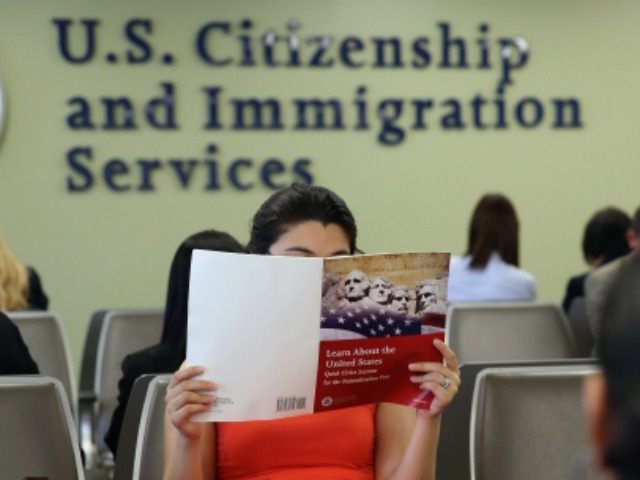America’s current “autopilot” immigration system that quietly admits millions of new foreign workers to the U.S. annually isn’t serving the needs of the American people, according to Sen. Jeff Sessions (R-AL) and Rep. David Brat (R-VA).
Sessions and Brat are arguing that candidates worthy of the White House must publicly commit to pursuing immigration policies that prioritize the American people over the desires of big business for cheap labor and advocacy groups for open borders.
“Anyone running for the White House who cannot publicly commit to these principles should consider a different occupation,” the pair write. “Americans should no longer have to wonder for whom their leaders work.”
In a lengthy op-ed published at Roll Call Monday, the two immigration hawks put the current state of America’s immigration system under a magnifying glass, pointing out that while the country is experiencing a seismic shift in population make up there has been little conversation about the changes or the repercussions.
“The Census Bureau projects that the foreign-born share of the U.S. population will soon eclipse the highest levels ever documented, and will continue surging to new record highs each year to come,” they write. “Yet activists and politicians who support unprecedented levels of immigration are never asked to explain how they believe such a policy will impact social stability, community cohesion or political assimilation.”
Sessions and Brat say that the goal of immigration policy should be to benefit Americans, and immigration reform should be in pursuit of that goal. However, they charge, the term “immigration reform” has been usurped to mean open-borders for cheaper labor.
They note that the failed “Gang of Eight” immigration reform would have doubled the number of tech workers in the U.S. and increased the number of low-skilled workers without asking essential questions about the effects of such an influx.
“This is not immigration reform. This is the dissolution of the nation state, of the principle that a government exists to serve its own people,” they write.
As an example of the disconnect, Sessions and Brat pointed to the recent layoffs at Southern California Edison and Orlando Disney in which the laid off employees were made to train their foreign replacements.
“No tears were spilled by a cultural elite who would march on Washington to get drivers’ licenses for illegal immigrants,” they write. “Instead of pleas for justice on behalf of these discarded workers, industry and lawmakers pushed for legislation that would accelerate their replacement. They demanded passage of the Immigration Innovation Act — a bill to triple the number of foreign tech workers brought in as lower-wage substitutes.”
According to Sessions and Brat there a key facts about America’s immigration history and future that have been willfully ignored including the that it was during periods of low immigration that the U.S. saw large increases in wages and growth of the middle class.
The Immigration and Nationality Act of 1965, however, served to change that, they explain, the “foreign-born population more than quadrupled, from less than 10 million in 1970 to more than 42 million today. In 1970, fewer than 1 in 21 residents were foreign-born, today it is approaching 1 in 7. In cities such as Los Angeles and New York, almost 4 in 10 current residents were born in another country. One-fifth of our residents now speak a language other than English at home. One-quarter of our residents is now either an immigrant or born to immigrant parents.”
The high level of immigration, in which a million green cards are approved annually, is expected to continue unless something changes. The status quo Brat and Sessions say, would result in the U.S. handing out more green cards than the combined populations of Iowa, New Hampshire and South Carolina.
“No nation on earth admits more new permanent immigrants each year than the United States,” they write. “No nation on Earth has more than one-fourth as many total immigrants as we do today. And no nation on Earth anywhere near as large ours has a higher percentage of foreign-born residents.”
In addition to green cards, the U.S. also annually issues some 700,000 temporary foreign worker visas, 500,000 student visas, and 100,000 refugees, they note.
“Lettered on our nation’s seal are the words E Pluribus Unum. Out of many, one. It does a disservice to both the country and the immigrant when we bring in larger numbers than we can reasonably expect to assimilate,” Sessions and Brat write. “If we allow our immigration system to replicate in America the same failed conditions which people have left, we are hurting the country and any who would seek to enter it in the future.”
With that in mind, the Alabamian and Virginian say the U.S. should limit the number of new arrivals to that which can be responsibly absorbed into “our schools, labor markets and communities. We must never admit so large a number that the immigrants themselves are unlikely to enter the middle class or achieve stable incomes.” Especially as so many remain without a job.
“After nearly half a century of massive immigration it is time to turn our attention to our own residents. It is time to help our own workers, families and communities — immigrant and U.S.-born — rise together into the middle class,” Sessions and Brat write.

COMMENTS
Please let us know if you're having issues with commenting.